RTP (Real Time Protocol)
Real-Time Protocol (RTP) is a transport protocol that was developed for streaming data. RTP includes extra data fields not present in TCP. It provides a timestamp andsequence number to facilitate the data transport timing, and allows control of the media server so that the video stream is served at the correct rate for real-time display. The media player then uses these RTP fields to assemble the received packets into the correct order and playback rate.
- Sequence number
The value of this 16-bit number increments by one for each packet. It is used by the player to detect packet loss and then to sequence the packets in the correct order. The initial number for a stream session is chosen at random. - Timestamp
This is a sampling instance derived from a reference clock to allow for synchronization and jitter calculations. It is monotonic and linear in time. - Source identfiers
CSRC is a unique identifier for the synchronization of the RTP stream. One or more CSRCs exist when the RTP stream is carrying information for multiple media sources. This could be the case for a video mix between two sources or for embedded content.
In a sense, RTP is not a true transport protocol, and it is designed to use UDP as a packet transport mechanism. In other words, RTP usually runs on UDP, and uses its multiplexing and checksum features. Note that RTP does not provide any control of the quality of service or reservation of network resources.
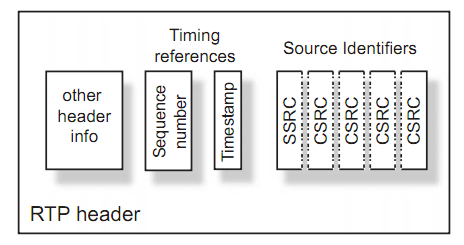
RTCP (Real Time Control Protocol)
RTCP is used in conjunction with RTP. In other words, whenever an RTP connection is made, an RTCP connection also needs to be made. This connection is made using a second neighboring UDP port; if the RTP connection uses port 1500, then the RTCP connection uses port 1501.
RTCP gives feedback to each participant in an RTP session that can be used to control the session. The messages includes reception reports, including number of packets lost and jitter statistics (early or late arrivals). This information potentially can be used by higher layer applications to modify the transmission. For example, the bit rate of a stream could be changed to counter network congestion. Some RTCP messages relate to control of a video conference with multiple participants.
RTCP provides the following features:
- Allow synchronization between different media types, such as video and audio. It has timestamp that is used by the receiver to align the clocks in each different RTP stream so that video and audio signals can be synced.
- Report reception quality to the senders.
- Provide identification of the senders in the RTP session so that new receivers can join and figure out which streams they need to obtain in order to participate fully.
Session Description Protocol (SDP)
SDP is a media description format intended for describing multimedia sessions, including video-conferencing. It includes session announcement and session invitation. Below is a sample of SDP.
v=0 o=- 32176 32176 IN IP4 13.16.32.209 s=ONetworkRenderer i=OLiveBroadcast c=IN IP4 221.1.0.1 t=0 0 b=AS:32 a=x-qt-text-nam:ONetwork Renderer a=x-qt-text-inf:OLive Broadcast a=x-qt-text-cmt:source application:ONetwork Renderer a=x-qt-text-aut: a=x-qt-text-cpy: a=range:npt=0- m=audio 22002 RTP/AVP 96 a=rtpmap:96 MP4A-LATM/44100/1 a=fmtp:96 cpresent=0;config=400024100000 a=control:trackID=1
The description of the sdp is shown below:
v: Version o: Originator, session identifier, version, network type, protocol type, address s: Subject i: Information c: Connection type, address t: Start and stop times m: Media type, port number, transport protocol, RTP profile a: Dynamic payload type description
When we changed something in the sdp, the client should start a new session to see the effect of the changes. It works the same way as the html file. The web server holds the new html pages, and a client needs to refresh the the page to see any changes made.
RTSP (Real Time Streaming Protocol)
RTSP provides a means for users to control media sessions. RTSP does not actually provide for the transport of video signals but it allows these signals to be controlled by a user. The RTSP (Real Time Streaming Protocol) is a network control protocol to control streaming media servers. The protocol is used for establishing and controlling media sessions between the the streaming server and client. RTSP is considered more of a framework than a protocol. RTSP is designed to work on top ofRTP to both control and deliver real-time content.
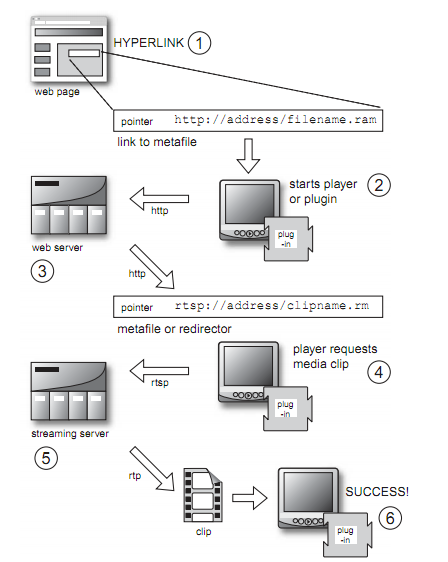
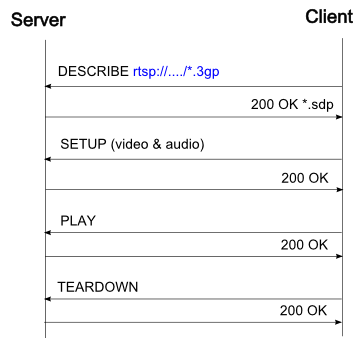
RTSP is one of the number of different protocols have been developed to facilitate real-time streaming of multimedia content. Streaming means that the mean frame rate of the video viewed at the player is dictated by the transmitted frame rate. The delivery rate has to be controlled so that the video data arrives just before it is required for display on the player. The associated audio track or tracks must also remain synchronized to the video. IP data transmission is not a synchronous process and delivery is by best effort. To achieve synchronism, timing references have to be embedded in the stream.
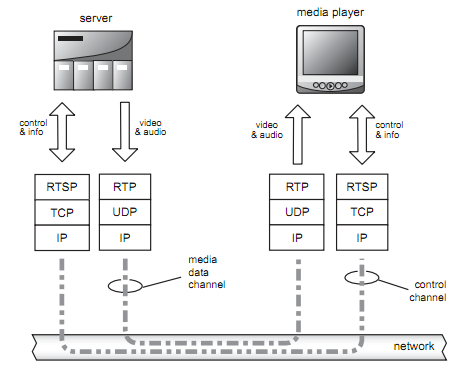
It delivers content as a unicast stream. It is an application-level protocol that was created specifically to control the delivery of real-time data, such as audio and video content. It is implemented over a correction-oriented transport protocol. It supports player control actions such as stopping, pausing, rewinding, and fast-forwarding.
If the connection URL uses RTSP, RTSP automatically negotiates the best delivery mechanism for the content. It then directs the RTP protocol to deliver streaming content using UDP, or using a TCP-based protocol on a network that does not support UDP.
The default transport layer port number is 554.
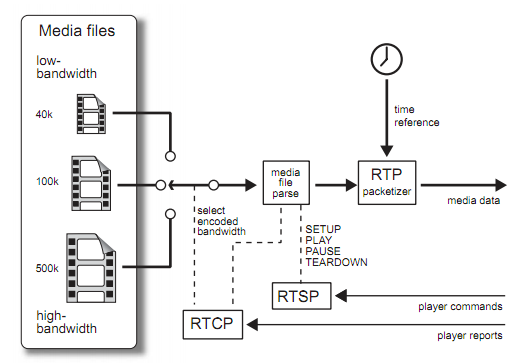

- OPTIONSAn OPTIONS request returns the request types the server will accept.
- DESCRIBEA DESCRIBE request includes an RTSP URL (rtsp://...), and the type of reply data that can be handled. The default port for the RTSP protocol is 554 for both UDP and TCP transports. This reply includes the presentation description, typically inSession Description Protocol (SDP) format. Among other things, the presentation description lists the media streams controlled with the aggregate URL. In the typical case, there is one media stream each for audio and video.
- SETUPA SETUP request specifies how a single media stream must be transported. This must be done before a PLAY request is sent. The request contains the media stream URL and a transport specifier. This specifier typically includes a local port for receiving RTP data (audio or video), and another for RTCP data (meta information). The server reply usually confirms the chosen parameters, and fills in the missing parts, such as the server's chosen ports. Each media stream must be configured using SETUP before an aggregate play request may be sent.
- PLAYA PLAY request will cause one or all media streams to be played. Play requests can be stacked by sending multiple PLAY requests. The URL may be the aggregate URL (to play all media streams), or a single media stream URL (to play only that stream). A range can be specified. If no range is specified, the stream is played from the beginning and plays to the end, or, if the stream is paused, it is resumed at the point it was paused.
- PAUSEA PAUSE request temporarily halts one or all media streams, so it can later be resumed with a PLAY request. The request contains an aggregate or media stream URL. A range parameter on a PAUSE request specifies when to pause. When the range parameter is omitted, the pause occurs immediately and indefinitely.
- RECORDThe RECORD request can be used to send a stream to the server for storage.
- TEARDOWNA TEARDOWN request is used to terminate the session. It stops all media streams and frees all session related data on the server.
A streaming server works with the client to send audio and/or video over the Internet or Intranet and play it almost immediately. They allow real-time 'broadcasting' of live events, and the ability to control the play-back of on-demand content. Playback begins as soon as sufficient data has downloaded. The viewer can skip to a point part way through a clip without needing to download the beginning. If the data can not be downloaded fast enough, a streamed web cast sacrifices quality in order for the viewing to remain synchronised with the original timing of the content.
With Windows Media Server, RTSP supports the following features:
- RTP packets can stream over UDP or over TCP. If the client can tolerate packet loss, streaming over UDP can be more efficient than TCP because UDP does not incur the overhead of retransmitting lost packets.
- The encapsulation of Advanced Streaming Format (ASF) packets in RTP is proprietary.
- The description of the ASF file, called ASF encapsulated in SDP, is proprietary.
- WMS supports retransmission of lost RTP packets sent over UDP. This behavior allows a client to give up on expired RTP packets, which in turn helps the client avoid falling behind after losing packets.
- WMS supports a forward error correction (FEC) scheme for RTP packets.
- Streaming with RTSP fails if a firewall separates the client and server, and the firewall blocks the ports and protocols that RTSP uses. This problem is especially common with home Internet gateways. Even if the gateway has a built-in RTSP NAT, streaming might fail at times.
- RTSP has the overhead of requiring multiple requests before playback can begin. However, the client can pipeline many of these requests and send them over a single TCP connection, in which case WMP does not need to block waiting for a response.
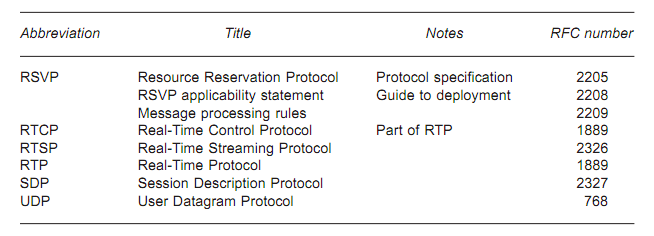
No comments:
Post a Comment